Today I’d like to share Postcard 8, an image of Lenin’s Tomb in Moscow, although it is postmarked from Leningrad. Because this isn’t 100 years old and because I’m only sort of confident all the named characters are dead, I’m going to blur-and-initialize to minimize the searchability of this post. (But I fully acknowledge that there’s so much information on this family it would take a half-sober monkey five minutes with Google to find them.)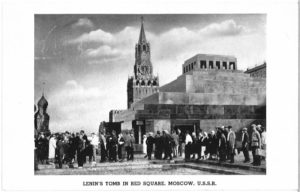
This postcard came from eBay in 2014. It’s dated July 25, 1938, is addressed to a person with a clear name and address, and features the following tender words:
My dear little Herzchen, Aunt Jeannette & I send loads of love to your Mommy & Daddy. Grandma Johanna
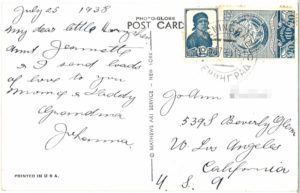
From a research perspective, this card had a lot of potential. Los Angeles city directories from the 1930s are online. Of course, this card appears to be addressed to a child, and a female child at that, so it wasn’t going to be a slam-dunk to find either the recipient or her grandmother. But I was pretty sure I could do it.
There are a couple hundred people in the Los Angeles directory of 1938 with this last name, and in the end, Miss Jo Ann’s family were actually not among them. I don’t know why they’re not listed in the directories anywhere; maybe they were renters. I finally found them by hoping they were at the same address in the 1940 Census.

That too was a little complicated because their house was right after a street change and the online catalog had the address wrong. But I finally found them with a little playing around and learned that Jo Ann was barely a toddler when her loving grandmama sent her this card. She is listed as just over 2 years old in 1940!
From there it was mostly downhill: father Fred was a hotel manager in LA, and he and mother Maxine traveled a lot during their marriage. They had two kids, and Maxine remarried before Fred’s death, so I’m guessing they eventually divorced. Their son (also Fred) died recently; I can’t find much about Jo Ann. A nice, normal family, upper middle-class enough to have a live-in servant. Nothing very exciting.
It’s Grandma who’s interesting!
I mean, first of all, it’s 1938 and Grandma’s rocking out in Leningrad.

The American part of this family’s saga starts in 1846 when Salomon S. arrived from Germany with at least one of his brothers. The woman who would be his wife, Sophie R., arrived in 1854, and I have absolutely no idea how they met, but they got married in Ohio just months after her arrival, so perhaps they knew each other back home. They immediately set about having a bazillion children in Chicago. Salomon is described several places as “not wealthy” and “a grocer,” but like many immigrants, his kids did better than their father. Son (and relative hotty) Moses was a lawyer, notably representing the Central Labor Union and some of the anarchists involved in the Haymarket Bomb cases in Chicago in the late 1880s. He later became a state senator. Grandson Irving was a business tycoon, Roosevelt crony, and United Nations Ambassador. And the family as a whole seems to have been heavily involved in the steel industry in New York and Chicago, at least according to various criminal and civil complaints filed on their behalf and against them.
Salomon’s fifth son, Joseph, is the tie to my postcard. Joseph was himself a bit of a macher, involved in the family’s steel ventures and filing at least a couple patents for pretty things made out of steel. He served a little time after mishandling the estate of a hotel magnate who may or may not have been married to a woman who may or may not have authorized the estate transfer; his brother Moses (also named in the suit, and with more than a whiff of impropriety about the whole thing) appears to have fought valiantly on his behalf.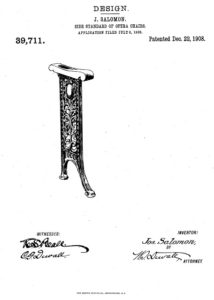
At some point in the late 1800s or early 1900s, a German fraulein named Johanna K. immigrated to the United States. I can’t find much about this, but she ended up spending a lot of time with two men I assume were her brothers, so the family came over together or reconnected in Chicago. Johanna’s family was also well-connected or very entrepreneurial and also involved in the steel industry, so I assume that’s how she met Joseph. They married in 1906 and nine years later Joseph, Johanna (yes! a woman listed on a business document!), and Johanna’s likely-brother Max put up $50,000 and incorporated the Royal Metal Manufacturing Company of Chicago. I’m not sure exactly what that means, legally speaking, because the RMMC existed before 1915, but it’s an interesting side note. The RMMC ended up being a pretty big deal in the art deco art world and was the money behind nephew Irving’s career pre-diplomacy.

Not just a random chair: an RMMC art chair!
Joseph and Johanna thrived and made enough money to be involved in several seriously major lawsuits, including one against the city of Chicago that I can’t read because it’s sealed. They had three kids, one of whom was Jo Ann’s mother Maxine. And they loved to travel. After Joseph died in 1930, Johanna traveled with her daughter Jeannette but also, as far as I can tell, by herself, including months-long stays in the UK and Puerto Rico.
And then, of course, there’s the 1938 expedition to Leningrad, about which I can find absolutely nothing…



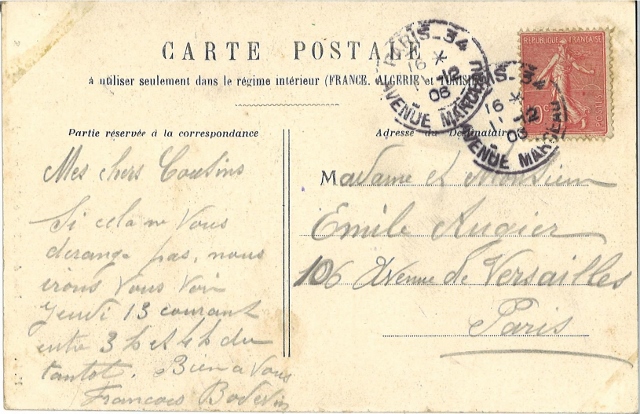

 Her father was born in the US but lived much of his life in Europe, and her mother was born in France but had a celebrity history in the US, and they will be a post unto themselves. Isabelle married Emile in 1908 and they had four sons and a daughter, the latter of whom died at 11 years old. The Augier household was frequently mentioned in Parisian who’s-who publications in the early 1910s.
Her father was born in the US but lived much of his life in Europe, and her mother was born in France but had a celebrity history in the US, and they will be a post unto themselves. Isabelle married Emile in 1908 and they had four sons and a daughter, the latter of whom died at 11 years old. The Augier household was frequently mentioned in Parisian who’s-who publications in the early 1910s.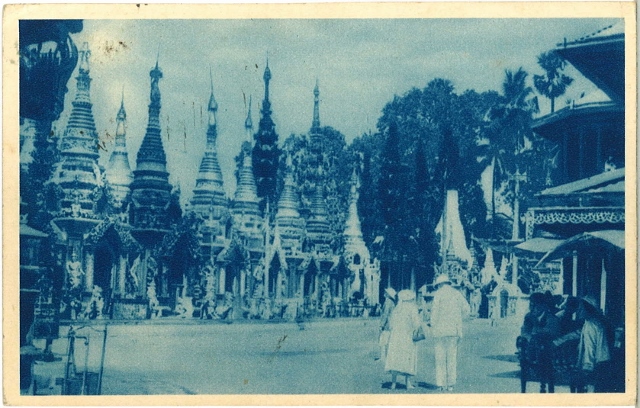






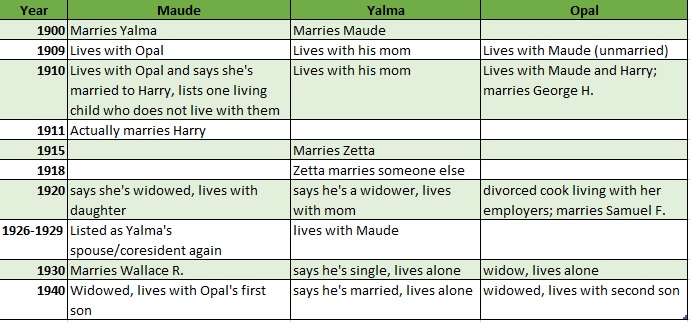



 old, and sent it to her 19-year-old niece. It says:
old, and sent it to her 19-year-old niece. It says: One of those kids was a mail carrier but also moonlighted as a photographer. I have no idea if he took the picture that became this postcard, but he had a little studio in their town, so I like to think he did.
One of those kids was a mail carrier but also moonlighted as a photographer. I have no idea if he took the picture that became this postcard, but he had a little studio in their town, so I like to think he did.










 at some point someone had erased the addressee’s name, leaving behind only the vaguest scratches, and the writer only used her initials. So I knew this card was mailed to a married woman at a rural route postal box in Wisconsin in 1922, by a person with the initials H.E. who lived in a different city. I am proud of figuring this one out!
at some point someone had erased the addressee’s name, leaving behind only the vaguest scratches, and the writer only used her initials. So I knew this card was mailed to a married woman at a rural route postal box in Wisconsin in 1922, by a person with the initials H.E. who lived in a different city. I am proud of figuring this one out! 